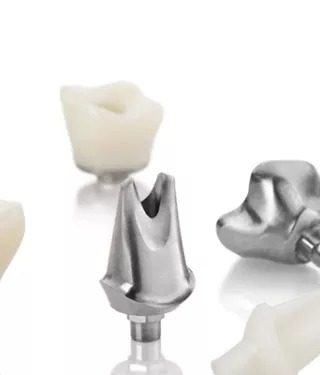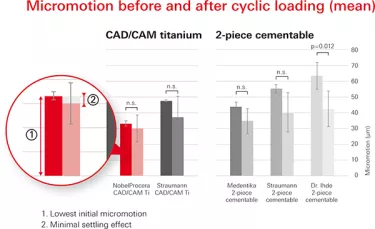
Non-original abutments are “a lottery that you cannot win”: research into micromotion at the implant-abutment interface.
The NobelProcera implant-abutment interface showed low initial micromotion and a better dental implant stability in a recent study.
In a recent study analyzing the effect of cyclic loading on micromotion at the implant-abutment interface, the authors found that a quantifiable settling effect seems to be more pronounced in non-original abutments.1 In the in-vitro study, the NobelProcera implant-abutment interface showed the lowest initial micromotion and minimal settling effect. We spoke with co-author Prof. Dr. Matthias Karl, Saarland University, Germany, about the results, the importance of choosing original components and what this means for clinicians in practice.
Micromotion and implant-abutment interface: interview with Prof. Karl
Why is it important for clinicians to know about micromotion in general regarding the implant-abutment assembly?
Prof. Dr. Karl: “From a prosthodontist’s perspective, the interface between the implant and what goes on top of the implant is, in my opinion, the most critical interface in implant dentistry. To my knowledge, it’s still impossible to manufacture two parts that fit perfectly. Perfect means zero micrometers of gap but there is always a certain amount of component interplay.”
“This is also needed by the implant manufacturers, because different parts from different batches have to match each other. As a consequence, during dynamic loading and mastication there will be some micro-movement between the abutment and the implant. This may cause fatigue over time.”
What were the findings of your study?
Prof. Karl: “We studied different abutments for Straumann tissue-level implants. In particular, we were analyzing the impact of third-party abutments on a major implant brand. Interestingly, we found out that there are differences between different abutment manufacturers. In general, you are on the safe side as a clinician if you go with an original abutment. Otherwise, you end up in a lottery that you cannot win. At best you get a product which is more or less comparable to an original one, but as we could show the chances are low.”
“We did this investigation twice with the status of the abutments as received from the different manufacturers and after some dynamic loading in our masticatory simulator. These micromotion measurements showed that with NobelProcera Abutments there is hardly any difference in abutment seating before and after dynamic loading, which is indicative of the fact that the NobelProcera restoration is in its final position. Once it’s screwed in by the dentist it stays there. If you have settling it means that the preload of your retention screw is basically gone and this does not happen with NobelProcera Abutments.”
Are there any other implications that these findings might have for clinicians in practice?
Prof. Karl: “If you’re not sure whether the implant-abutment is fully seated or whether it might experience some settling, you may need to go back after a couple of weeks and re-tighten the abutment screw. If you have cemented your crown on top of the abutment, then it’s a major inconvenience to take off the crown. I prefer abutments that I can seat correctly the first time.”
You talked a little bit about NobelProcera. Compared with the other abutments in your study, how did NobelProcera Abutments perform?
Prof. Karl: “The advantage of NobelProcera Abutments over other third-party abutments is that they’re precision-engineered individualized CAD/CAM abutments. Although it was a Straumann implant that was used as a basis for testing, we could demonstrate that NobelProcera Abutments showed less micromotion compared with standard abutments from Straumann for cement restorations.”
What do you attribute this result to?
Prof. Karl: “NobelProcera manufacturing quality is extremely high. The result of this study is indicative of very consistent and precise manufacturing.”
More to explore
References
1. Karl M, Taylor TD. Effect of cyclic loading on micromotion at the implant-abutment interface. Intl J Oral Maxillofac Implants. 2016.
